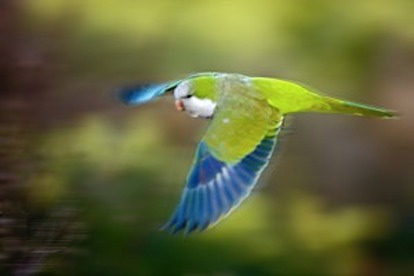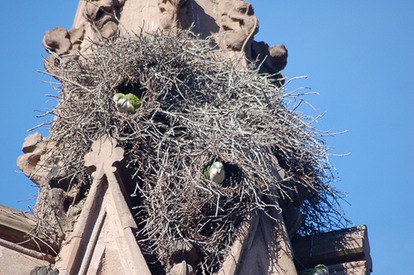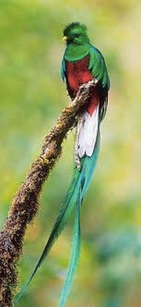My life is more than my work
COSTA RICA: We once visited the rain forest in Costa Rica for 45 minutes on our own, waiting for a walk-through with a guide. With the guide, we not only saw so much more, but we all, especially Liz, learned to see. She even spotted 2 or 3 birds before our guide did by the end!
Liz's paintings almost always have an amorphous background, a softened, fuzzy-focus human figure, and a small, sharp, tight object. A year after the trip, she realized that almost all of the small, sharp, tight objects in her paintings that year were specific birds and some other creatures, anatomically correct. That has remained mostly true in the last decade. Thus began our bird-watching.
Costa Rican quetzal
SMARTS, SIGHTS & SOUNDS: Liz is the one that enjoys the research part of bird-watching, studying them in ID books so that she can distinguish one from another in the field. And unlike me, she visually remembers her reading ... a useful skill. I can augment her skill as a 2nd pair of eyes, and I do a decent job of painting verbal descriptions ("the wing-tips were more pointy than rounded, but not knife-y like a swift"). I also have the better ear. Liz once said "I heard something nearby." I said "I heard something robin-sized rustling in dry leaves behind that rock." It turned out to be a chipmunk dancing hula in a grass skirt ... OK, I'm lying ... a robin rustling leaves.
Liz always gets us a bird book for our trips, whether to Puerto Rico or Southeast Asia or wherever. She favors light, pocket-sized books with a good index for the field; if you want encyclopedic, take a smart phone (on mute). You can access the Internet, or, yes, there are apps for that. For casual reading not in the field, she likes to look at Peterson and Sibley guides. I continue to piggyback on her reading.
PROSPECT PARK: Great as it is in general to have Prospect Park as our "backyard", it's a great bird-watching site in particular, with its own Audubon Center. Besides the many native Brooklyn "boids", it's on the pathway of the Spring and Fall fly-over of migrating birds. Anytime we're in Prospect Park to bird-watch, someone else with binoculars approaches us. Mostly they're members of the Brooklyn Bird Club, and will come over and share their knowledge & sightings, and ask and answer questions.

Monk dinosaur in flight
GREEN-WOOD CEMETERY: Yes, that's how it's officially spelled. Also part of the Atlantic Flyway, Green-Wood, unlike Prospect Park, has some fruit trees, and so is home to a great many Quaker parakeets, a.k.a. monk parakeets (parrots despite the name). Other than that, similar birds, both resident and migrant, are found at Green-Wood and Prospect Park.
MONKS: We also have monks all around us in our Woodmont, Connecticut summer weekend home, but not so near as to wake us every dawn with the raucous sun-greeting of 300 dinosaurs. I've seen some monk nests of that size and larger that were surrounded by "for sale" signs in neighboring human homes. I read long ago in Science News about a similar specie of parrot, the Carolina parakeet, the only one native to the United States, long ago hunted to extinction. Like monks, they were never seen alone; hunters saw one fly out the canopy, aimed at its exit point, and waited for the next ... then the other Carolinas returned to hover over fallen comrades, only to fall victim next. They ate the same fruits and grains as monks, and they built the same communal twig nests (we refer to them as "condos"). So when monk parakeets arrived in the U.S. in modern times (late 1960's to early '70's), they found an empty, unused ecological niche and fit right in, speculated Science News. Green-Wood now welcomes their monk parakeets, because chemical analysis shows that their poop does not damage stonework, which is not true of the pigeons they "gentrified." Outside of the cemetery, however, their condos are a hazard to power lines and transformers; monks seem to like these as nesting sites. Those twig nests for 300 get heavy, and they warm transformers that were meant to cool off up there.

A small "condo" of monk parakeets in Green-Wood Cemetery
HAWKS: It's not all monks here. From a car window in Green-Wood, I once watched a red-tail hawk at lunch not ten feet away on a tree stump, eviscerating a squirrel. Bird-watching's not for the squeamish. Hey, you dinosaur, my mammal ancestors looked like that! Red-tails also nest in Prospect Park, once right above the roadway. Lower down in the same tree nested what became known as "Squirrely Knievel"; he'd even sneak up to the *occupied* hawk's nest to steal nesting material! That's a Brooklyn squirrel for ya!
On our neighbor's porch in Woodmont, we once had an up-close-and-personal moment with a red shouldered hawk. These are *big* ... 24 inches before the tail. It landed with a clang on our neighbor's outdoor grill, probably looking for the fish or meat it smelled there, indicating it knew woods better than 'burbs. I called out from our downstairs porch to Liz on the upstairs porch. When she answered me, we saw some hawk hunting-behavior; since a watcher was higher than it was, the hawk flew to a treetop to be higher still.
HONORARY BROOKLYN: Another treasure of NY area bird-watching is the Jamaica Bay Wildlife Refuge. No, it's not quite in Brooklyn, but we'll forgive it that. It's in mid-Jamaica Bay, which is triangulated by Brooklyn, JFK Airport, and the Rockaways. According to their website, "there are more than 330 bird species that have been sighted at the refuge over the last 25 years; that is nearly half the species in the Northeast." New York City glossy ibis, anyone? I saw them here.

